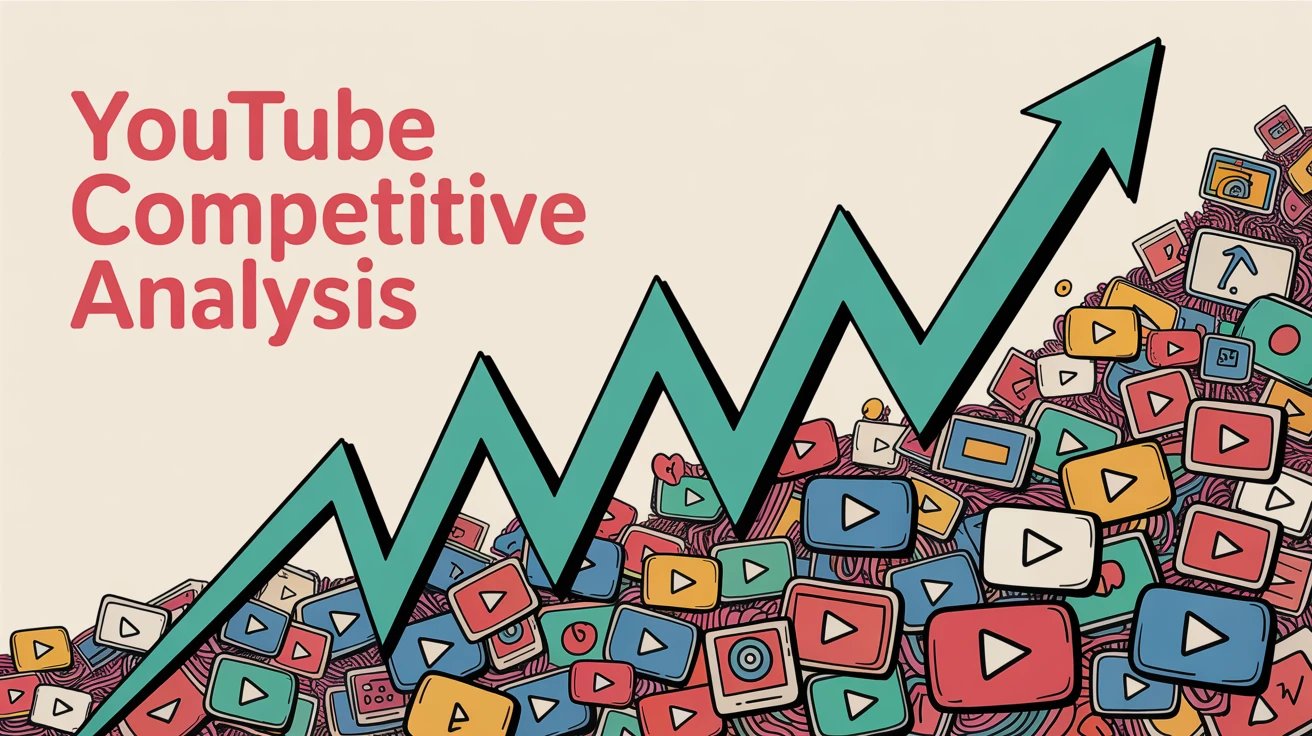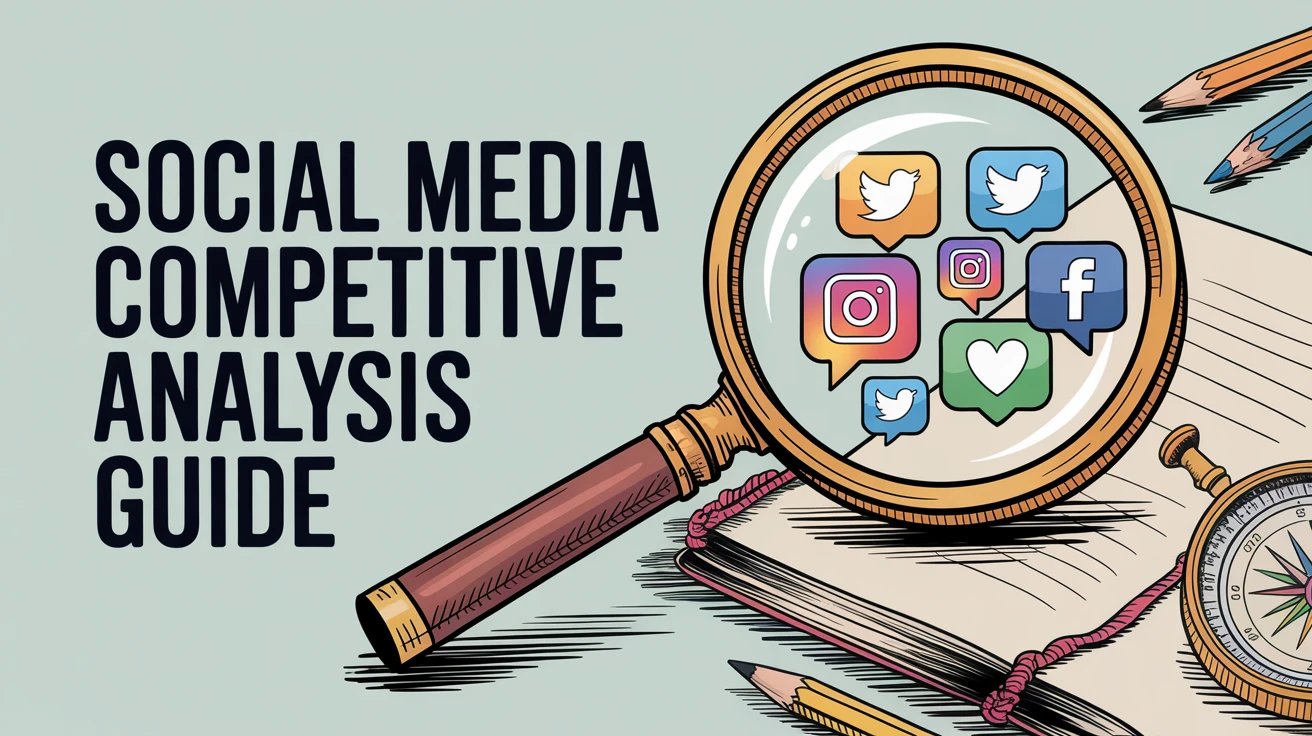Quick Summary
Over 500 hours of video content flood YouTube every minute. In this environment, understanding your competition isn't optional anymore.
YouTube competitive analysis gives marketers, creators, and brands a structured way to monitor rival channels, understand what drives engagement, and identify growth opportunities. Instead of guessing what works, you can use data to see exactly which content formats, posting schedules, and topics are winning in your niche.
Shortimize helps you monitor any creator, competitor, or brand across YouTube, TikTok, and Instagram from one dashboard. For more cross-platform analytics tips and insights, visit our blog.
Why YouTube Competitive Analysis Matters for Your Channel
Research shows that over 500 hours of video are uploaded to YouTube every single minute. That's not a typo. Every 60 seconds, creators worldwide publish more content than you could watch in three weeks straight.
In this flood of content, manual tracking of competitor performance becomes impossible. You can't realistically check five rival channels daily to see their latest view counts, engagement rates, and subscriber growth. And without that competitive intelligence, you're making content decisions in the dark.
YouTube competitive analysis solves this problem.
It's a structured way to evaluate competitor performance and discover what actually drives results in your niche. By tracking the right metrics and patterns, you can spot opportunities before your rivals do, avoid their mistakes, and refine your strategy with real data instead of hunches.
We've built Shortimize specifically for this: monitoring creators and brands across YouTube and other platforms, so teams can make faster, smarter decisions about their content strategy.
This guide walks through how to perform YouTube competitive analysis step by step. You'll learn what metrics to track, how to gather and compare data efficiently, and how to translate those insights into concrete improvements for your channel.
Why Trust Shortimize for Competitive Analysis?
At Shortimize, we've built a data-driven platform that hundreds of marketers and creators trust for YouTube and cross-platform competitive analytics. Our users track thousands of channels daily, uncovering the patterns behind viral videos and rapid audience growth.
Teams at companies like Amo, Airbuds, and Reclip rely on us to benchmark performance and find actionable insights.
We live and breathe social video analytics. Every feature we've built comes from real competitive analysis challenges that marketers face daily. Check out our Customers page to see how teams use our platform to stay ahead of their competition.
What Is YouTube Competitive Analysis?
YouTube competitive analysis is the process of tracking competitors' channels to evaluate their content, performance metrics, audience engagement, and growth trends. You're looking at what your rivals are doing on YouTube and using that intelligence to inform your own strategy.
What Metrics Should You Track for Competitors?
When you analyze competitors on YouTube, you're monitoring:
| Category | What You Track | Why It Matters |
|---|---|---|
| Content strategy | Video types, length, topics, frequency | Reveals what content resonates with shared audience |
| Performance patterns | Top videos, engagement rates, view trends | Shows what actually works vs. what doesn't |
| Growth trajectory | Subscriber growth, momentum, plateaus | Indicates whether they're accelerating or declining |
| Audience engagement | Like ratios, comment volume, retention | Measures how deeply viewers connect with content |
Common Use Cases
Content optimization means finding out what resonates with your target audience by seeing what works for competitors. If a rival's tutorial videos consistently outperform their vlogs, that's a signal about audience preference you can act on.
Trend discovery helps you spot emerging formats before they become saturated. Maybe competitors are jumping on YouTube Shorts, or they're experimenting with live streams. Early awareness gives you a chance to capitalize on these trends.
Campaign benchmarking lets you measure your YouTube marketing campaigns against industry peers. Are your video ads performing above or below average? You won't know without competitive context.
Influencer evaluation becomes crucial when you're considering collaboration opportunities. Analyzing an influencer's competitors reveals what content style succeeds in their niche and whether their metrics are genuinely strong or just average.
Why Manual Tracking Doesn't Scale
Picture manually checking five competitor channels every week. You'd need to visit each channel, write down subscriber counts, note their latest videos, calculate engagement rates, and track it all in a spreadsheet.
The reality: Manual tracking is tedious, error-prone, and doesn't scale. Miss a week and you lose continuity. Track more than a handful of channels and it becomes a full-time job.
Tools like Shortimize automate this entire process. You can track any public YouTube channel by simply pasting a URL. The platform pulls every video, calculates aggregate stats, shows growth charts, and even reveals optimal posting schedules and video length patterns.
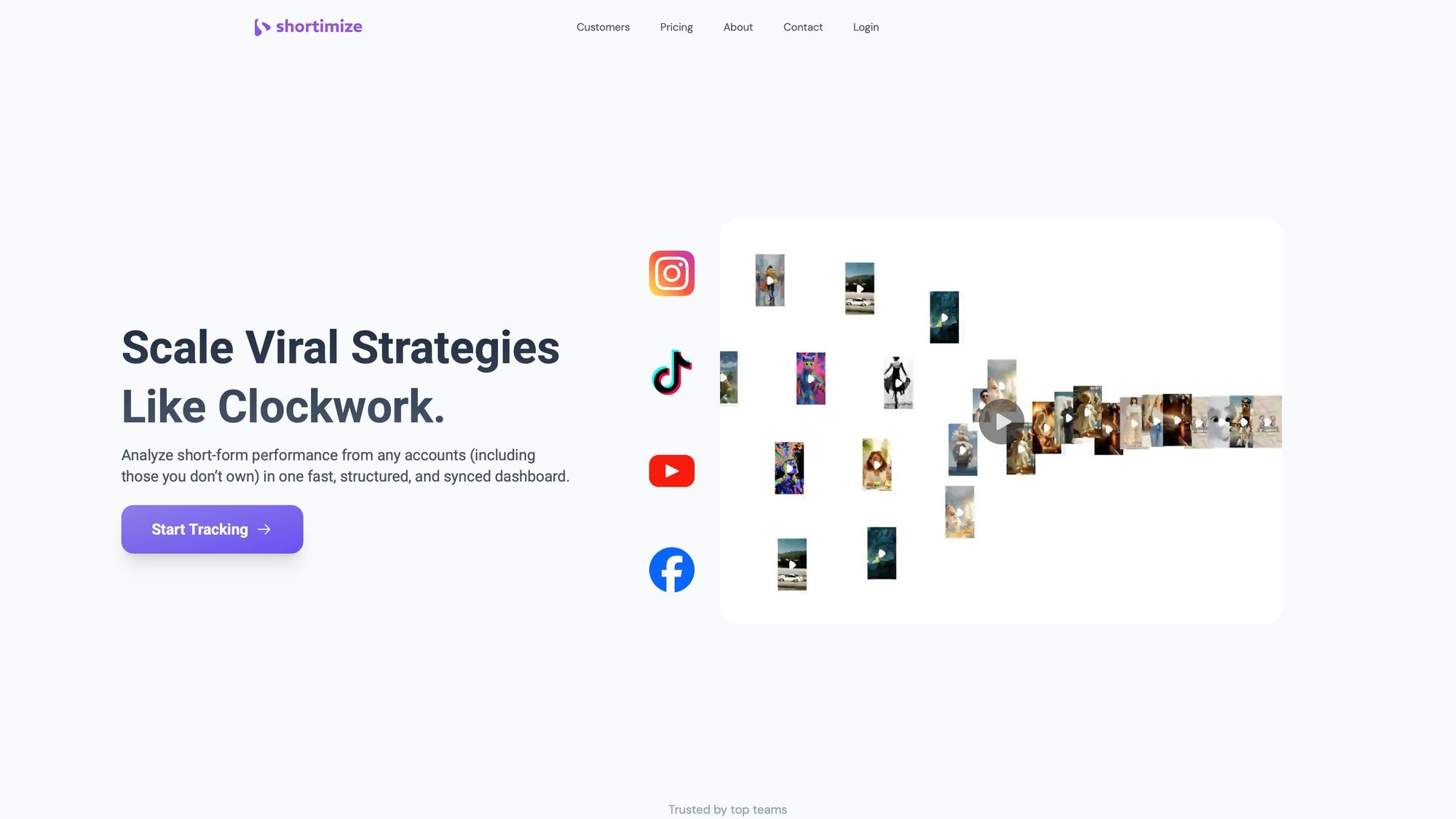
Instead of juggling spreadsheets and browser tabs, you get a single dashboard showing exactly how competitors perform across YouTube, TikTok, and Instagram.
How to Conduct YouTube Competitive Analysis
Ready to start analyzing your competition? Here's the complete process.
Step 1: Identify Key Competitors
The first step is deciding which YouTube channels you'll analyze. These should be channels that operate in your niche or target a similar audience.
Your direct business competitors are the obvious choice. If you run a tech review channel, other tech reviewers are natural competitors. If you're a fitness brand, other fitness channels competing for the same viewer attention need tracking.
But think broader. Your real competitors aren't just businesses selling similar products. They're any channel competing for your viewers' time and attention. This could be independent creators in your space, or even brands from adjacent niches that appeal to the same demographic.
How to Find Relevant Competitors
Start with YouTube search using keywords related to your niche. If you run a cooking channel, search for "easy recipes" or "vegan meal prep" and see which channels appear prominently.
Pay attention to:
→ Search results for your target keywords
→ Related channels sections on popular channels in your niche
→ Suggested videos when you watch content similar to yours
If you have YouTube Studio access, check "Other videos your audience watched" and "Other channels your audience watches." These insights reveal creators with overlapping audiences.
Aim to gather 5-10 key competitor channels. That's enough to see patterns without becoming overwhelming.
Using Discovery Tools
Shortimize's Similar Accounts feature can suggest related creators you might have missed. This is particularly useful for finding rising stars or niche players that aren't yet on your radar.
Industry research shows that knowing exactly which channels to track is half the battle. A well-chosen competitor set makes everything that follows more meaningful.
Take your time with this step. The quality of your analysis depends entirely on tracking the right channels.
Step 2: Gather Competitor Data
Now you need to collect key data points for each competitor. You'll want both high-level channel metrics and video-level statistics.

Essential Metrics to Track
| Metric Category | What to Measure | Why It's Important |
|---|---|---|
| Subscriber Growth | Total count + monthly gain rate | Shows audience size and momentum |
| Upload Frequency | Videos per week/month | Affects algorithm treatment and audience expectations |
| View Performance | Average views per video | Indicates typical reach and engagement baseline |
| Engagement Rate | Likes + comments as % of views | Reveals audience loyalty and content resonance |
| Content Mix | Video types, formats, lengths | Identifies what formats work in your niche |
| Posting Schedule | Day/time patterns | Shows consistency and optimal timing |
Subscriber count and growth: How many subscribers does each channel have? More importantly, how fast is that number growing? A channel with 100K subscribers gaining 5K per month is more interesting than one with 500K subscribers gaining 500 per month.
Total videos and upload frequency: How many videos have they published total? How often do they upload new content? Some channels post daily, others weekly, some irregularly. This affects how the algorithm treats them and how audiences anticipate content.
View counts: Look at both total channel views and average views per video. Are recent videos consistently hitting a certain view count? Identifying that baseline helps you set realistic expectations.
Engagement metrics: Track likes and comments per video. Calculate engagement rate as a percentage of views. If a video gets 10,000 views and 500 likes, that's a 5% engagement rate. High engagement rates usually indicate loyal audiences or particularly compelling content.
Video topics and formats: Catalog the types of content they produce. Tutorials? Vlogs? Product reviews? Challenges? YouTube Shorts? Live streams? Note typical video length and production style too.
Posting schedule: Do they maintain a consistent schedule (every Tuesday at 3pm) or post sporadically? Consistency affects audience anticipation and algorithm momentum.
Automating Data Collection
Manually gathering all this data is exhausting. You'd be clicking through dozens of videos, copying numbers, updating spreadsheets.
Shortimize automates this entire process. Input any public YouTube channel URL and the platform retrieves all these metrics automatically. You get every video listed with views, likes, and comments, plus aggregate stats like average views and total engagement.
Our dashboard saves hours and ensures accuracy. No more transcribing numbers by hand or missing data points.
Don't Forget Historical Context
A channel's current subscriber count tells you something. But the trajectory over the past six months tells you more. Is growth accelerating or slowing down?
If you start tracking with Shortimize now, you'll monitor growth going forward with regular updates (every 12-24 hours depending on your plan).
The goal in this step is building a complete profile for each competitor: their reach, typical performance, activity level, and momentum.
Step 3: Analyze Content Performance
Raw numbers only take you halfway. Now you need to interpret what they mean.
Start with qualitative analysis of your competitors' content to understand why certain videos perform well or poorly.

Identify Top Performers
Look at which videos have the highest view counts or engagement on each channel. Are there clear standouts? Maybe a particular tutorial got 10× the views of their average video.
These outliers indicate topics or formats that strongly resonate with the audience. Make note of every pattern you see.
Examine Formats and Length
Among top (and bottom) performers, what patterns emerge?
Maybe your competitor's 2-minute product highlights consistently outperform their 15-minute vlogs. Or their YouTube Shorts (vertical 60-second videos) bring massive view surges compared to regular uploads.
Research shows YouTube Shorts surpassed 50 billion daily views by 2022 and have grown exponentially since. Many channels see huge performance boosts from viral Shorts content.
Note whether competitors are utilizing Shorts, live streams, premieres, and community posts. Track how those formats perform relative to standard uploads.
Study Thumbnails, Titles, and SEO
A video's success on YouTube often comes down to click-through rate, which is driven by the title and thumbnail.
Do your competitors use high-contrast, eye-catching thumbnails? Do they feature faces or bold text? Are video titles optimized with strong keywords or clear value propositions?
For each top-performing video, note what made it appealing to click. This informs your own thumbnail and title strategies.
Look at Audience Engagement
Click into a few high-engagement videos and scroll through comments.
What is the audience saying? Are there recurring questions or requests? Viewers might repeatedly ask a tech reviewer to cover a specific product. That's direct market demand for content the competitor hasn't delivered yet.
Observe the tone of engagement. Are fans praising the content, critiquing it, or having discussions? This reveals the community strength around the channel.
Comments are often a goldmine for content ideas. It's essentially free market research straight from your target audience.
Assess Consistency and Branding
Is the competitor consistent in their niche or do they experiment broadly?
A channel that sticks to a specific focus (drone photography tutorials) usually builds a more loyal following than one posting random unrelated content. Check if competitors maintain consistent style, branding, and posting rhythm.
Critical insight: Always ask "why might this be working (or not)?" when you analyze patterns. Competitor A's weekly Q&A live streams might have lower views than polished uploads, but those streams generate more comments and foster community. That's a deliberate strategic trade-off.
Step 4: Benchmark Key Metrics
With data collected and performance context understood, the next step is benchmarking. Direct comparison tells you where you stand relative to others and sets reference points for goals.
Choose Metrics That Matter
Common KPIs for YouTube benchmarking include:
• Subscriber count and growth rate (new subscribers per month)
• Average views per video
• Total views (lifetime or per month)
• Engagement rate (likes and comments per view)
• Posting frequency
You might also include average video length or other metrics depending on your goals. Research suggests you should focus on metrics most important for your specific objectives.
If your goal is increasing engagement, focus on like and comment rates. If it's reach, focus on views and subscriber growth.
Create a Comparison Chart
Build a simple table listing each competitor with their metrics side by side for a recent period (last 30 days or last 10 videos).
Visualizing data makes it easier to spot outliers and understand competitive positioning. Many analytics tools do this automatically. Shortimize, for instance, lets you add multiple channels to a collection and view combined reports.
Here's what a comparison might reveal:
| Channel | Avg Views | Upload Frequency | Engagement Rate | Monthly Growth |
|---|---|---|---|---|
| Competitor A | 150K | Moderate (8/month) | 5.2% | +2,500 subs |
| Competitor B | 85K | Low (3/month) | 7.1% | +3,800 subs |
| Competitor C | 220K | High (12/month) | 4.8% | +1,200 subs |
Analysis: Competitor C leads in average views (~220K) but uploads very frequently (12 videos/month), which inflates view counts. Competitor B has a higher engagement rate (7% of viewers engage) despite fewer videos, indicating an audience that's highly responsive to each upload. Competitor A sits in the middle with moderate output and engagement.

These comparisons help you determine who wins on which metric and where opportunities exist to improve your own channel.
Set Realistic Targets
From benchmarking, you might discover insights like:
Competitor X gains 5,000 subscribers per month, double my growth. What are they doing differently?
Competitor Y's engagement rate is 8%, well above the group average of 5%. Their audience is clearly more engaged. Is it content style or calls-to-action?
Use these findings to set realistic targets. If the average view-to-subscriber ratio in your niche is 10% and you're only getting 5%, you might aim to reach that 10% benchmark by trying tactics competitors use.
Context Is Important
A channel with 1 million subscribers will have different absolute numbers than one with 50K subscribers. Percentages and ratios (engagement rate, growth rate, views per subscriber) are great equalizers for benchmarking.
It's often more insightful to benchmark growth rates and engagement rates because those can be achieved regardless of channel size. A smaller channel might have higher engagement than a larger one, indicating a passionate niche audience.
Step 5: Identify Gaps and Opportunities
Competitive analysis isn't just tracking metrics. It's about discovering opportunities you can exploit.
Look for what your competitors aren't doing or where they're underperforming. Turn those gaps into your advantage.
Content Gaps
As you reviewed competitors' content, did you notice topics your audience cares about that aren't being covered?
If multiple viewers on Competitor X's channel keep asking for a tutorial on a specific feature that hasn't been made, that's a content gap. Perhaps none of the competitors have addressed a trending question or niche sub-topic.
These gaps are your chance to create content that has demand but low supply.
Compile a list of "topics to cover" from:
• Competitor comments and community posts
• Trending searches in your niche
• YouTube's Research tab (if you have 1,000+ subscribers)
Fill those gaps before your rivals do.
Underused Formats
Is there a format your competitors haven't fully embraced?
YouTube Shorts represents a massive opportunity in 2025. If your competitors mostly create 10-minute long-form videos and barely touch Shorts, you could dominate the Shorts space for your niche.
Why does this matter? YouTube Shorts see tens of billions of views daily, with over 2 billion monthly users scrolling these bite-sized videos. If your rivals are late to Shorts, you can attract a large audience there and direct them to your long-form content.
Check out our guide on how the YouTube Shorts algorithm works to understand why some Shorts blow up in the 200+ billion daily views ecosystem.
The key is leveraging formats competitors underutilize, whether that's Shorts, live Q&As, YouTube Community posts, or features like Chapters and End Screens.
Quality and Strategy Gaps
Beyond topics, assess how competitors execute their content.
Do you notice weaknesses? Maybe a competitor has great information but poor video editing or audio quality. Viewers notice these things.
If top channels in your niche all have similar styles, there might be an opportunity to differentiate with a unique approach: humor, storytelling, higher production value, or something else audiences would appreciate.
Another strategic gap could be cross-platform presence. Perhaps none of your YouTube competitors repurpose content on TikTok or Instagram Reels. You could become the multi-platform leader, reaching audiences your YouTube-only competitors miss.
Shortimize tracks creators across platforms, letting you see if a big YouTuber is also succeeding on TikTok or not. Cross-platform analysis might reveal an influencer dominating YouTube but weak on Instagram, meaning you could take the lead there.
Keyword and SEO Opportunities
Look at keywords your competitors target in titles and descriptions versus ones they neglect.
Specialized tools can identify high-volume search terms in your niche. Are your competitors ranking for those terms?
If you find relevant keywords with decent search volume that none of the top competitors have optimized for, that's low-hanging fruit. This is the "keyword gap" analysis bloggers often reference.
Also consider language and regional opportunities. If all your competitors make English content but there's a growing audience for Spanish-language content in your niche, you could fill that void.
Audience Feedback and Sentiment
Revisit competitor comment sections with a critical eye.
What do viewers complain about? On a competitor's channel, people might say "you talk too fast" or "wish you would show more examples."
These are opportunities to differentiate your content style by addressing those pain points. Speak at a comfortable pace. Include more examples. If audiences express desires that competitors aren't delivering, you can.
Step 6: Implement and Monitor
The last step is putting your insights into action and setting up ongoing monitoring.
Competitive analysis isn't one-and-done. The YouTube landscape changes quickly. New competitors emerge, algorithms update, viewer preferences shift. Continuous monitoring keeps you ahead.
Integrate Insights Into Your Strategy
Take the gaps and opportunities you identified and translate them into an action plan.
If you decided to start making Shorts, set a schedule: "post 2 Shorts per week focusing on trending questions." If you found your thumbnails were weaker than competitors', plan a thumbnail redesign for upcoming videos.
Use competitive benchmarks as targets. Maybe you aim to match Competitor A's posting frequency or Competitor B's engagement rate within the next quarter. Make these goals specific and trackable.
Set Up Regular Reporting
Choose a frequency for reviewing competitor metrics. For most channels, monthly is a good cadence, with lighter weekly checks for rapidly changing metrics.
A weekly glance catches viral breakouts. If a competitor suddenly has a video going viral, you'll notice the spike in views or subscribers and can analyze what happened.
A monthly deep dive updates your benchmarking table and tracks progress over time.
Using an analytics tool automates much of this. In Shortimize, you can create a dashboard of selected competitor channels. It auto-refreshes stats every day (Business plan updates every 12 hours, Pro every 24 hours per our pricing).
You could have a monthly report showing each channel's growth and top content, ready for analysis without manual effort.

Leverage Alerts and Notifications
Many platforms offer ways to get alerts on competitor activity.
On YouTube, you could subscribe to competitors and click the notification bell to be alerted of new uploads.
For a more advanced approach, Shortimize provides smart notifications. You can get Slack or email alerts when a tracked video hits a certain milestone or when a competitor's video suddenly goes viral.
Imagine being notified that Competitor X just had a Shorts video blow up to 1 million views. You could quickly analyze that video and adapt the idea for your channel while it's trending.
Use APIs for Scale
If you're a marketer or part of a team that needs to integrate YouTube data into broader business intelligence, consider using an API.
YouTube has an official Data API (though it has quota limits and requires coding). Shortimize offers an API and webhooks for paying users, so you can pipe competitor data into your own dashboards or data warehouse.
For example, you might integrate competitor metrics into a Google Data Studio or Tableau report alongside your own channel's metrics for comprehensive visibility.
The key benefit is automation. It reduces manual work and ensures you don't forget to check something important.
Stay Updated on Platform Changes
Monitoring isn't just about numbers. It's also about context.
YouTube algorithms and features evolve. A policy change in 2025 might suddenly boost community posts, or a new metric might become available in YouTube Studio.
Stay plugged into YouTube news through industry resources and the official YouTube Creator Blog. When changes happen, reassess your competitive analysis criteria.
Reevaluate Your Competitor Set Periodically
As you monitor, you might discover new channels rising in your niche or old ones becoming irrelevant.
It's healthy to refresh your competitor list annually. Also consider your own growth: channels that once dwarfed yours might now be peers, and new aspirants might be looking at you as their competitor.
Keep the analysis dynamic by including or excluding channels as needed to get the most insightful comparisons.
Best Practices for YouTube Competitive Analysis
Competitive analysis involves a lot of data and moving parts. To ensure you get maximum value without losing focus, keep these best practices in mind:
1. Track Regularly for Consistency
Make competitive analysis a recurring routine, not a one-time project. By tracking competitors' performance consistently (weekly or monthly), you can distinguish meaningful trends from one-off spikes.
Regular monitoring helps you see patterns like seasonal slumps or viral surges and react appropriately. If you review competitor stats every Monday, you might notice that one channel gains subscribers steadily right after their Sunday video uploads. That's a pattern you could emulate.
Consistent tracking ensures you're never blindsided by a competitor suddenly leaping ahead. You'll see it coming and understand why.
2. Focus on Actionable Metrics
It's easy to get overwhelmed by vanity metrics on YouTube: total views, subscriber count, etc.
Prioritize metrics that drive decisions.
Engagement rate tells you how well content resonates relative to reach. If a competitor has a 2× higher like-to-view ratio than others, that's worth investigating.
Watch time and audience retention are gold-standard metrics for quality. A competitor whose viewers consistently watch 80% of each video is hitting a content sweet spot.
On the other hand, raw view count without context might mislead. One million clicks mean little if people bounce after 5 seconds.
Focus on metrics like:
• Average view duration
• Engagement (likes/comments per view)
• Subscriber growth rate
• View-through rate for Shorts
These are actionable because you can work to improve them, unlike a competitor's 10-year-old cumulative view count.
3. Analyze Across Platforms
Don't limit your analysis to YouTube alone.
Today's creators and brands are often present on multiple platforms, and audience behavior differs across them.
Evaluating how YouTube competitors perform on TikTok, Instagram Reels, or Facebook can reveal content opportunities and threats.
A competitor might be quiet on YouTube but massive on TikTok. Is there a content style they've mastered on TikTok that could migrate to YouTube? Or perhaps all top YouTubers in your niche also maintain Instagram communities. If one hasn't tapped into Instagram, you could dominate there and funnel followers to YouTube.
With a cross-platform view, you can also see if a drop in YouTube activity corresponds to a rise on another platform. Maybe a competitor shifted focus to TikTok. Learn more about how to conduct TikTok competitor analysis to understand this dynamic.
Shortimize excels here by letting you monitor creators on TikTok, Instagram, and YouTube side-by-side, giving you a holistic picture.

The video ecosystem is interconnected. Cross-pollinate your analysis to stay ahead.
4. Leverage Automation
Your time is better spent interpreting data than collecting it.
Take advantage of automation for tracking and reporting. Set up tools like Shortimize to auto-track competitor channels, so new data flows in without manual effort.
Use features like scheduled reports or dashboards that update themselves. Automation reduces human error and ensures you won't forget to capture a data point.
Plus, set up alerts for significant changes. You could automate an alert if a competitor's subscriber count jumps by more than 5% in a week, indicating a possible viral event.
Many social media analytics tools, as well as services like Google Alerts, can notify you of keywords or changes (news articles about a competitor's channel, sudden social buzz).
By leveraging automation, you stay informed 24/7 without dedicating all your hours to monitoring. Plus, it frees you to focus on analysis and strategy, which is where your insight is most valuable.
5. Visualize Data for Clarity
A picture is worth a thousand data points.
When communicating findings to your team (or organizing your own thoughts), use visualizations to make comparisons clear.
Charts, graphs, and tables highlight differences between you and competitors instantly.
A simple bar chart of "average views per video" for you versus competitors immediately shows who's ahead. Line graphs illustrate subscriber growth trajectories over time, revealing who's accelerating or plateauing.
Consider creating a dashboard that includes:
• Line chart for each channel's monthly subscriber growth
• Bar chart for engagement rates of last 10 videos across channels
• Table comparing key metrics side by side
Many tools (Shortimize, social analytics platforms, Excel, Google Sheets) allow easy creation of such charts.
Visuals not only make data digestible but often uncover insights that aren't obvious from raw numbers. You might literally see a trend forming.
Plus, visualizing for presentations or reports ensures stakeholders quickly grasp the competitive landscape. Annotations on charts (marking "YouTube algorithm change here" or "Competitor launched new series here") add valuable context.
Don't leave your competitive analysis buried in spreadsheets. Bring it to life with charts and infographics so it's clear and actionable.
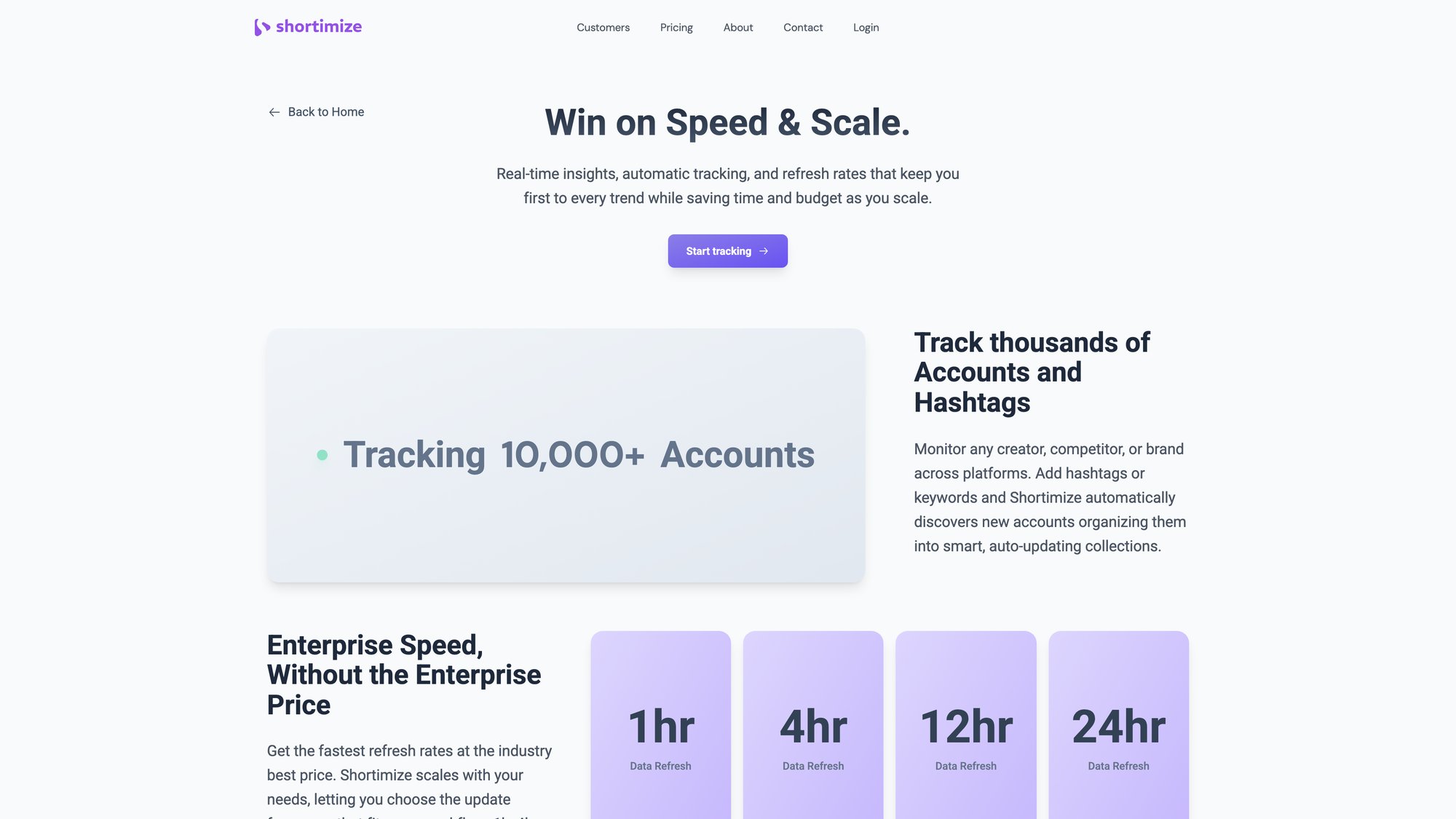
Conclusion
In YouTube's fast-paced environment, understanding your competition isn't a luxury. It's a necessity.
YouTube competitive analysis gives you a window into what's working (and not working) for others in your space. You can refine your strategy with data-backed confidence instead of guesses.
By identifying key competitors and tracking their performance over time, you gain context for your own channel's metrics. You'll know whether 10% engagement is amazing or average, whether posting twice a week is sufficient, and which content trends to jump on or avoid.
More importantly, you'll uncover opportunities: those gaps in content or platform usage that your brand can fill to differentiate itself and capture audience attention.
The goal isn't to copy your competitors. It's to learn from them. Take the best ideas and run with them in your own unique way. Take note of their missteps to avoid similar pitfalls.
The competitive landscape in 2025 is always evolving, but with a solid analysis process, you'll feel like you have a map instead of flying blind.
Crucially, the right tools make this journey much easier. Platforms like Shortimize are designed to be your co-pilot in monitoring any creator, competitor, or brand across YouTube and other social channels.
Instead of manual tracking, Shortimize automates the heavy lifting: pulling the latest stats, alerting you to big changes, and letting you visualize multi-channel performance at a glance. You spend less time gathering data and more time using data.
To thrive on YouTube, keep your eyes open. Watch what others are doing, benchmark it, and continuously iterate your approach.
Start tracking your competitors today with Shortimize and gain actionable insights that translate into better content, smarter growth strategies, and a stronger presence on YouTube. With data on your side, you can outmaneuver the competition and captivate your audience like never before.
FAQ
What is YouTube competitive analysis and why is it important?
YouTube competitive analysis is the process of examining other YouTube channels (usually those in your niche or market) to evaluate their strategies, content, and performance metrics.
Research indicates it involves looking at competitors' view counts, subscriber growth, video content, and engagement to understand how they attract and retain viewers.
This analysis is important because it helps you learn from others' successes and mistakes. Rather than operating in a vacuum, you gain insight into what types of videos or tactics resonate with your shared audience.
Competitive analysis shows you the benchmark for success in your space and highlights opportunities to differentiate your channel. It's crucial in today's crowded YouTube environment. If you know what your competitors are doing, you can strategically do it better (or find a gap they missed).
This leads to a more effective content strategy and faster channel growth.
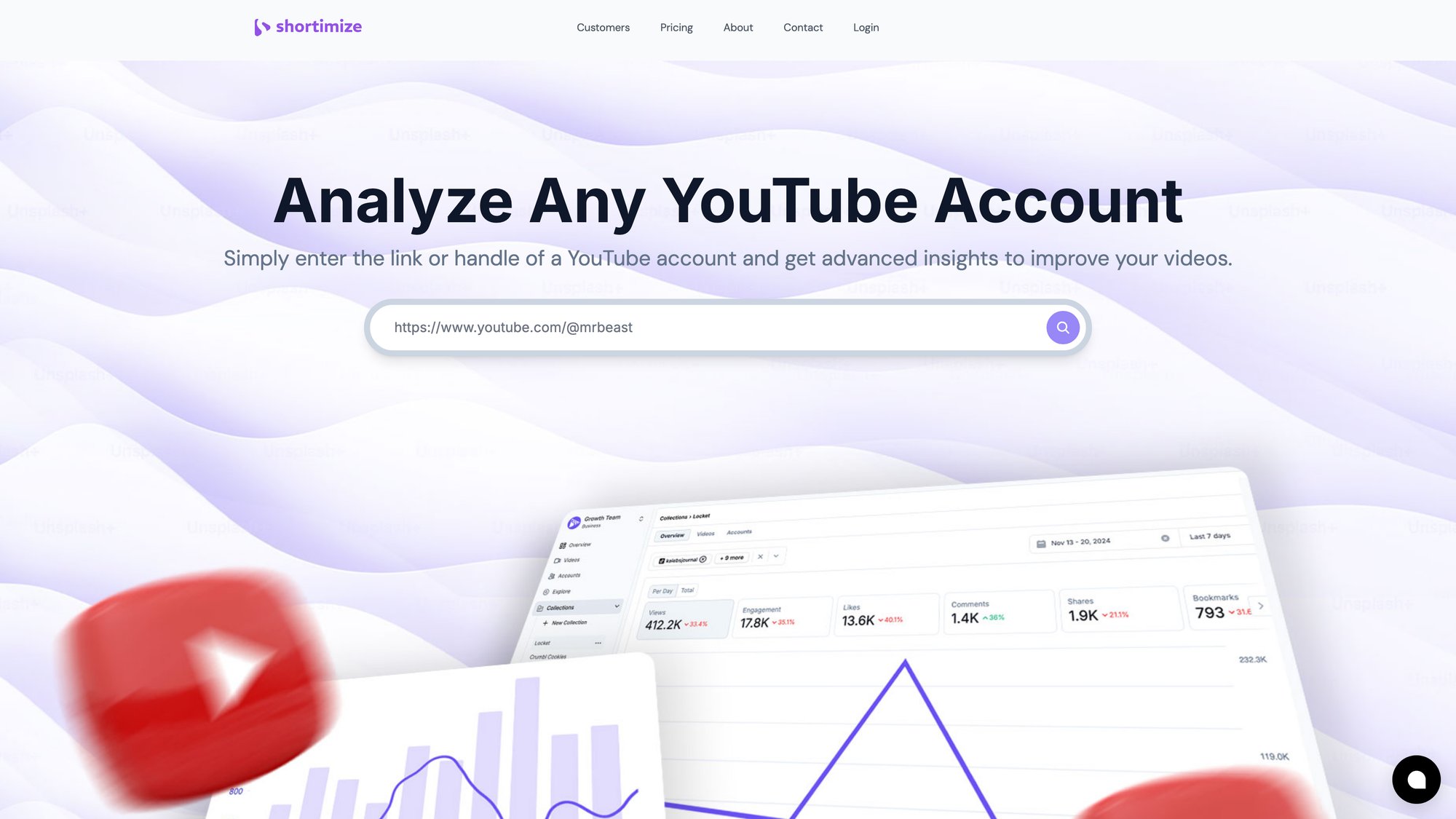
How can I track my competitors' YouTube channels?
There are several ways to track competitors on YouTube.
The simplest manual method is to subscribe to their channels and turn on notifications so you're aware of new uploads and community posts. You can periodically check their "About" page for total views and recent subscriber milestones, and manually note views and likes on their latest videos.
But manual tracking becomes tedious and you might miss data.
A better approach is using analytics tools designed for social media monitoring. Shortimize allows you to input any public YouTube channel link and will automatically pull that channel's stats (views, subscribers, engagement, latest videos) into a dashboard.
These tools let you add multiple competitors and will update data daily or weekly, saving significant time.
Also, YouTube's API (if you're technically inclined) can fetch channel statistics programmatically.
In practice, many marketers use a combination: setting up a tool for core metrics, while also keeping an eye on the competitor's channel feed for qualitative aspects like new content or community sentiment.
The key is consistency. Whichever method you choose, track competitors on a regular schedule so you can spot trends.
Which metrics are best for benchmarking YouTube performance?
When benchmarking YouTube channels, focus on metrics that reflect both reach and engagement.
Key ones include:
| Metric | What It Shows | Why It Matters |
|---|---|---|
| Subscriber count & growth rate | Audience size and momentum | Reveals whether they're accelerating or slowing |
| Average views per video | Typical reach per piece | Great indicator accounting for both subs and viewer tune-in |
| Watch time / avg duration | Content quality and retention | Shows if people actually watch (you can infer patterns externally) |
| Engagement rate | Likes/comments as % of views | Reveals audience connection depth |
| Upload frequency | Videos per week/month | Provides context for total output vs per-video performance |
Industry research suggests it's useful to benchmark these metrics because they mix size metrics (subscribers, views) and engagement metrics (likes, comments, retention) to give a full performance picture.
These let you gauge not just who has the biggest audience, but who is utilizing their audience most effectively.
Can I monitor multiple YouTube creators with one tool?
Yes. There are tools specifically built to monitor multiple YouTube channels in one place.
Social media analytics platforms often have a "competitor analysis" feature where you can add several YouTube channels and compare their metrics.
Shortimize lets you track an unlimited number of creators or accounts across platforms. You can create a collection of competitors and the tool will update each channel's data automatically, showing you comparisons in a dashboard (views, followers, engagement side by side).
These tools are very useful. Instead of checking each channel manually, you log in and see all the key numbers at a glance. They often provide visual comparisons and even PDF reports.
Monitoring multiple creators is absolutely feasible with one tool. In fact, that's the efficient way to do it. The exact number of channels you can track may depend on the tool or plan, but platforms like Shortimize are designed for scale (tracking dozens or even hundreds of accounts for enterprise use).
Whether you want to watch 3 competitors or 30, you can see all their vital stats in one unified view.
How does Shortimize help with YouTube competitor tracking?
Shortimize is a cross-platform analytics tool that makes competitor tracking on YouTube (and other short-form video platforms) extremely convenient.
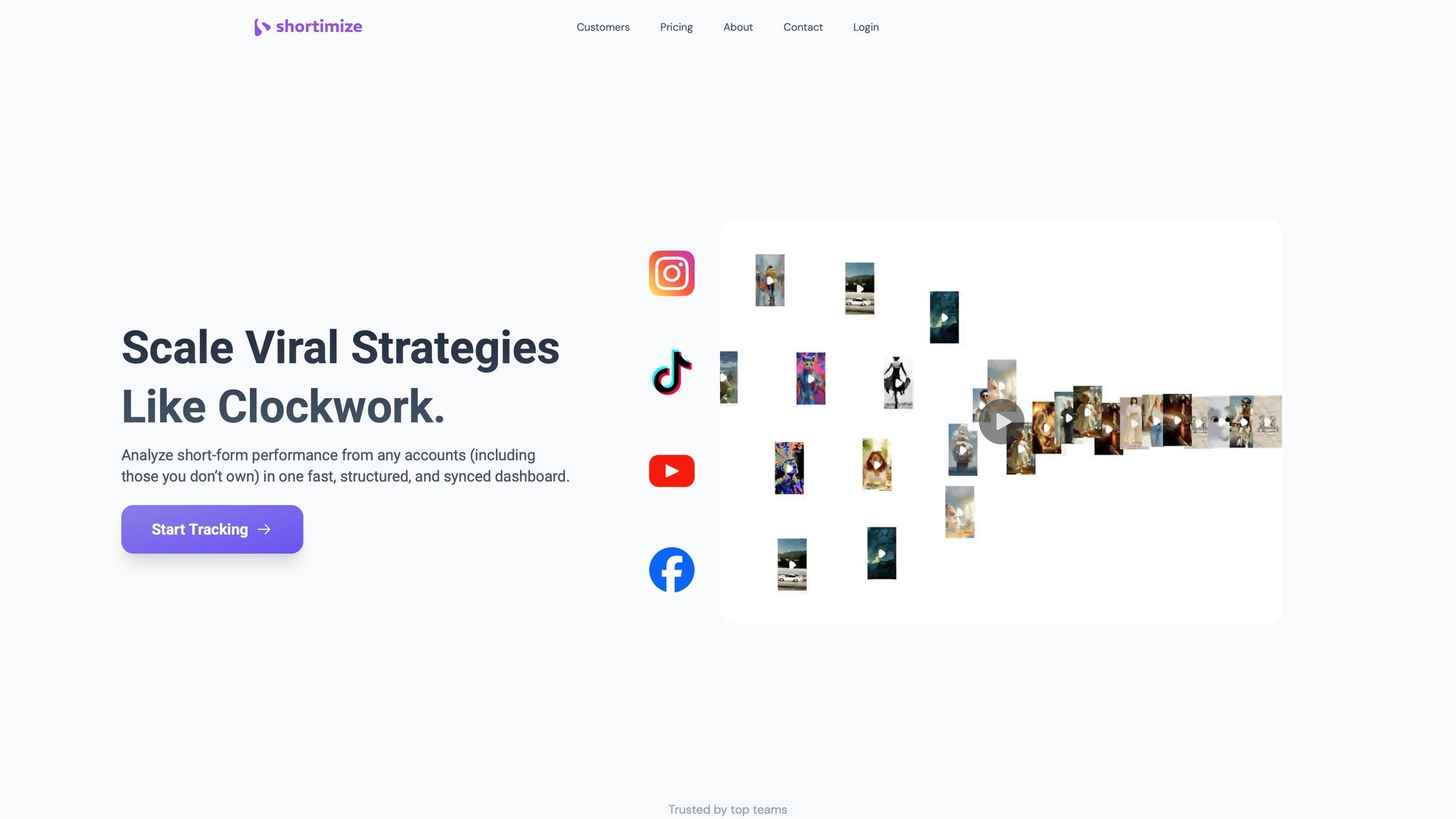
You can track any public YouTube channel just by entering its URL or handle. You don't need special access to that channel. Once added, Shortimize automatically pulls in data like subscriber count, total videos, and every video's performance metrics (views, likes, comments).
It updates these stats regularly (daily refresh on standard plans, up to 12-hour refresh on higher plans per our pricing) so you're always looking at current numbers. Essentially, it provides a live dashboard of your competitors.
Beyond raw data, Shortimize offers analysis features perfect for competitive benchmarking. It calculates median views and virality metrics for videos, helping you spot which videos are outliers on a competitor's channel.
It also visualizes trends: you can see a competitor's growth over time plotted in charts, their posting schedule, and even their optimal video lengths (the tool highlights which video durations get the most views for that channel).
Another unique feature is Similar Accounts & Videos. After analyzing a channel, Shortimize suggests related creators and top videos in the same niche, revealing additional competitors or inspiration you might not have been aware of.
Shortimize isn't limited to YouTube either. If you're tracking a brand or creator across platforms, it merges data for TikTok, Instagram Reels, and YouTube Shorts. You can monitor a competitor's presence on all three and compare how they're performing on each.
It will notify you of significant changes (a video suddenly going viral, a competitor hitting a milestone). For teams and power users, Shortimize also provides an API and webhooks so you can integrate data into your own reports or get alerts via Slack, Discord, etc.
Shortimize acts like a centralized command center for competitor analytics, sparing you the chore of manual tracking. It's particularly helpful if you have many competitors or value cross-platform insights.
How often should I perform YouTube competitive analysis?
The frequency of competitive analysis depends on your channel size and how dynamic your niche is, but regular periodic analysis is recommended.
For most creators or marketers, doing a comprehensive review monthly is a good cadence. This allows you to account for enough data (a month's worth of uploads and growth) and spot meaningful trends, while not letting too much change occur before you look again.
In a monthly analysis, you'd update key metrics, compare to last month, see who grew, whose videos spiked, etc.
That said, there's value in some weekly monitoring as well, especially if you or your competitors upload frequently. A quick weekly check-in can catch short-term spikes. If a competitor had a breakout video this week, you'd notice the bump in views and subscribers and can watch that video while it's trending.
Weekly monitoring helps you keep pace with fast-moving trends. Some niches (gaming, news commentary) have weekly viral moments.
Think of weekly monitoring as staying informed, and monthly as doing deep-dive analysis.
For larger brands or those in very competitive spaces, some metrics might even be watched daily (during a product launch or campaign, you might daily track how competitor content is performing if time-sensitive). But for most, daily is overkill and not actionable unless you're really looking for immediate alerts.
Recommended approach:
① Weekly quick checks → Catch viral spikes and immediate trends
② Monthly deep dives → Full benchmarking and strategic analysis
③ Quarterly reviews → Big picture trends and competitor set updates
The key is consistency. Whatever interval you choose, stick to it so you can compare apples to apples over time and quickly react to changes.
What tools are best for YouTube competitor analytics in 2025?
In 2025, there are several excellent tools for YouTube competitor analysis, each with its own strengths.
YouTube-focused analytics tools: Specialized browser extensions provide data on YouTube videos and channels. They're great for competitor research on tags, SEO, and video performance metrics. These tools can show you a competitor video's tags, rankings, and social engagements. But these are often single-channel-at-a-time tools rather than multi-channel dashboards.
Social media analytics platforms: If you want to compare multiple channels side by side with visual reports, dedicated analytics platforms are useful. These give basic historical graphs for subscribers and views of any channel, handy for growth comparisons. More comprehensive platforms let you add competitors and have more in-depth reports (engagement metrics, content analysis). Some well-known social management suites also have modules for YouTube analytics and competitor tracking as part of their offering, though they're known more for management than deep analytics.
Cross-platform analytics tools: Shortimize is tailored for monitoring short-form video performance across YouTube, TikTok, and Instagram. This is especially relevant in 2025 as many creators span multiple platforms. Shortimize provides a unified view which is unique if you care about multi-platform presence, plus it has specialized features for short-form content (like Shorts analysis).
SEO and content tools: If your competitive angle is more about content gaps or SEO, specialized research tools can help. They have sections for YouTube keyword research and can sometimes identify which channels or videos rank for certain terms. While not a direct competitor analysis tool, they help you see where competitors get their traffic from (search-wise) and if there are keywords they rank for that you could target.
Native YouTube features: YouTube itself has introduced some competitive insights. In YouTube Studio's Analytics, there's a "Research" tab (still evolving) which can hint at what your viewers are searching for, and it might indirectly highlight competitor content. These native features are limited but worth checking.
The "best" tool depends on your needs. If you want a holistic competitor dashboard, Shortimize is a great choice with its cross-platform tracking capabilities.
The good news is that in 2025 there's a tool for almost every niche requirement, from free options for quick checks to advanced paid suites for in-depth analysis. Consider what features matter most (real-time tracking, cross-platform, report exporting) and choose accordingly.
Always take advantage of free trials to test a tool with your competitor set and see if it delivers the insights you need. Try Shortimize's 7-day free trial to experience automated competitive analysis across YouTube, TikTok, and Instagram.
